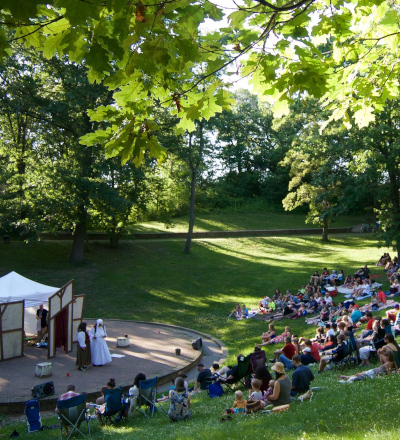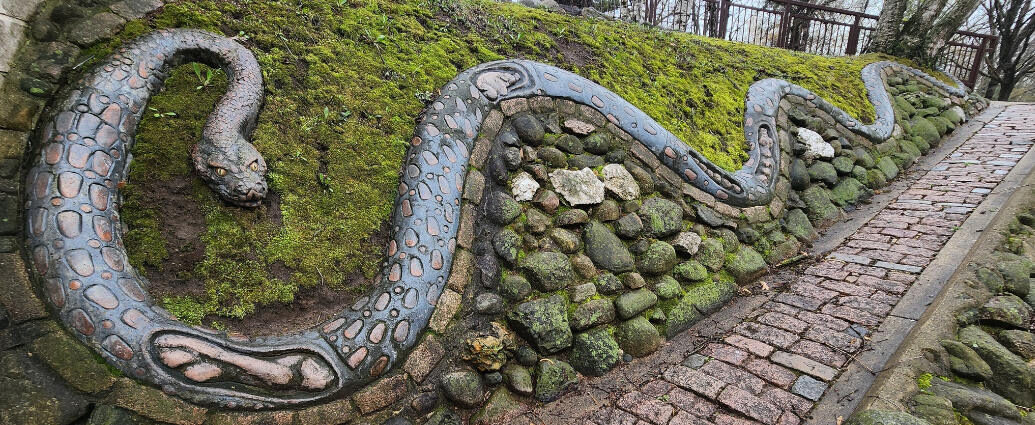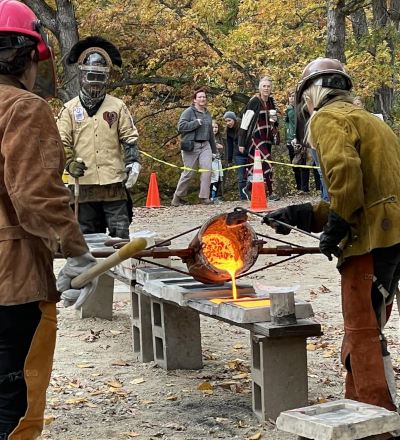 Caponi Art Park is an outdoor sculpture garden designed within the natural setting – literally a union of art and nature! This unique park welcomes over 18,000 annual visitors and is located on 60-acres of rolling, wooded hills that are embedded with art in Eagan, Minnesota; a distinctive community space offering cultural and educational experiences in an inviting, natural setting.
Caponi Art Park is an outdoor sculpture garden designed within the natural setting – literally a union of art and nature! This unique park welcomes over 18,000 annual visitors and is located on 60-acres of rolling, wooded hills that are embedded with art in Eagan, Minnesota; a distinctive community space offering cultural and educational experiences in an inviting, natural setting.
Caponi Art Park was conceived as an outdoor laboratory to teach and demonstrate how creativity is an essential part of daily living. From 1949 to 2013, Anthony Caponi, park founder, sculptor and Macalester College art professor, devoted himself to organically integrating art, life and nature into a 60-acre sculpture and a center for all the arts.
Opened to the public in 1987, Caponi Art Park has long been promoting environmental stewardship and public art and community involvement – what is now called creative placemaking. In the mid-1980s when Eagan was the fastest growing city in the country the Park’s founders asked city officials to look to the future and include a space for the arts from the beginning. While the primary concern was streets, and sewers etc. it was initially hard for them to envision that one day residents would need more than ballfields to build a community.

Where art and nature meet
While Caponi Art Park may have begun as the work of one person, in 1992 it was incorporated as a nonprofit to preserve and enhance Tony’s vision for generations to come. Performances by the region’s top artists began in 1996. Over the years the Park has hosted several artists-in-residence and commissioned new theatrical and musical works. It has become a thriving organization that is embraced by the community and all the stronger for its clear mission.
The Park is a leading cultural center in the south metro area, and a model for other communities who have been inspired by Caponi Art Park’s successful community collaborations and creative placemaking. The park is run by Executive Director, Cheryl Caponi, a board of directors, full-time and part-time staff members, seasonal interns and many volunteers.
This unique park features one of the largest outdoor amphitheaters in the region- Theater in the Woods, a unique setting for performances nestled in the park’s hilly landscape and surrounded by mature oak trees. A host of special events take place in the park and throughout the summer including Summer Performance Series, Yoga in the Park, guided tours, thoughtful performances and family-friendly public programs for all to enjoy. Check the events calendar for upcoming workshops and other opportunities to get involved with the park.
a walk in the park
The Park has miles of walking paths, a sculpture garden, outdoor amphitheater — the Theater in the Woods — as well as spaces for reflection and relaxation. Designed as a single, unified work of art the meandering trails follow the topography of the grounds like contour drawings animated by everyone who walks them, and the rock walls and shaped hills are the sculpture into which conventional works are integrated. Experiencing the Park is, in a sense, Caponi Art Park’s primary program.
Caponi Art Park provides accessible educational opportunities and offers a range of tours and workshops for all ages and abilities. They will work closely with you to create a park experience to meet your needs and program goals. Their tours and workshops introduce participants to art and creative activities through engaging nature-based projects. A guided tour is included with each workshop. Stand-alone tours are also available.
The Nature Tour highlights the flora and fauna of the park, environmental stewardship efforts, and how they’ve integrated their newest sculptures into the landscape. Participants will take in the view from the second highest point in Dakota County and visit the park’s Amphitheater.
A downloadable Nature Guide is available on the parks website, it allows visitors to discover the wonders of nature surrounding them when visiting Caponi Art Park. Imagine walking through one of the trails and spotting a bird or a flower, but you’d like to know more about – not a problem! You can pull up the Nature Guide on your cell phone and find out what you’re looking at! Or you can read and view pictures of the birds, plants and trees you’ll find in the park before you visit. It’s all up to you!
The sculpture tour will introduce participants to the park’s sculptures, their creation, materials, and the concepts of art they Illustrate. The tour covers some of the most prominent works in the park as well as the art park’s history.
There are over 55 sculptures scattered across the park including two permanent featured works: Wodakota Walk and the IRON50 project. The Sculpture Garden a work of art in itself with earthworks and sculptures waiting to be discovered along the wooded trails.
featured sculptures
The IRON50 project was undertaken to commemorate and exhibit the significant contribution of artists like Anthony Caponi, Wayne E. Portratz and Tamsie Ringler towards establishing the importance of the academic foundry for the Minnesota arts community and the international contemporary cast iron art movement.
In spring 2019, the Department of Art celebrated the 50th Anniversary of the University of Minnesota Annual Iron Pour. Founded by Professor Emeritus Wayne E. Potratz in 1970, the University of Minnesota iron pour was the longest running academic iron pour since the introduction of cast iron as a medium for contemporary sculpture in the early 1960s. In recognition of this important academic, cultural and historic event, the 50th Annual University of Minnesota Iron Pour celebrated the legacy and the future of iron casting as a medium for sculptural expression.
Recently the park invited artist Marlena Myles (Spirit Lake Dakota) to create Wodakota Walk, a permanent web-based, augmented reality installation that weaves Dakota stories into the landscape of the park. The five stops of the project are “a bridge to Indigenous values, lessons based on Dakota understandings, reveal our hidden kinship with plants and animals, and the natural cycles of Grandmother Earth.” Through digital art, animation, and sound visitors will experience visions of the past, present, and future.
The grounds are not merely a backdrop for art, but an integrated environment that adds to the experience of the programs and activities in the park. This intentional blending of man-made and natural beauty creates an atmosphere of openness and discovery that makes the arts approachable for everyone.




